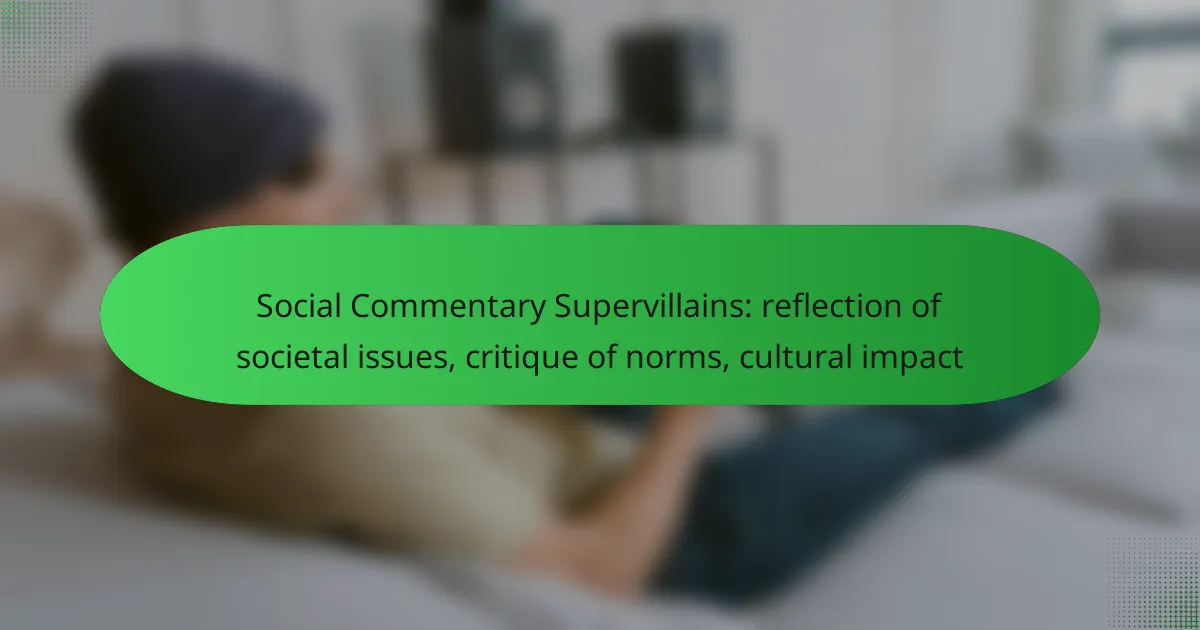Social commentary supervillains act as powerful symbols of societal issues, critiquing established norms and exposing systemic flaws. By embodying the fears and frustrations of marginalized groups, they encourage audiences to confront complex social dynamics and reflect on their own values. Through their exaggerated traits and narratives, these characters illuminate cultural tensions and inspire critical discourse in contemporary society.
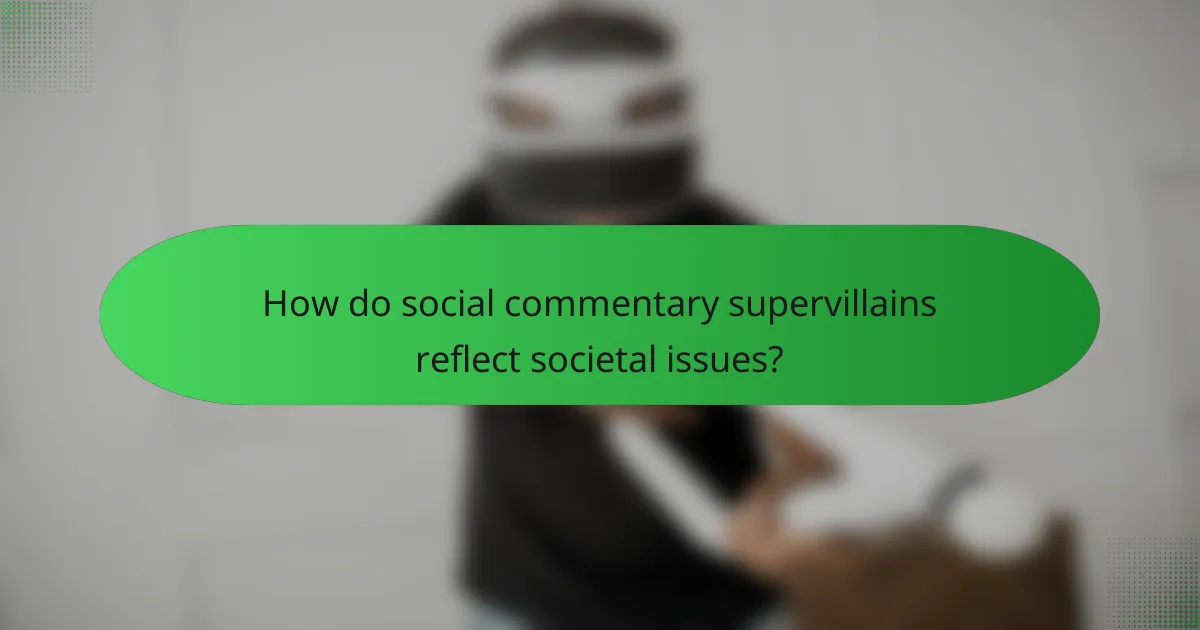
How do social commentary supervillains reflect societal issues?
Social commentary supervillains serve as exaggerated representations of societal issues, critiquing norms and highlighting the flaws within various systems. They often embody the fears and frustrations of marginalized communities, offering a lens through which audiences can examine complex social dynamics.
Representation of marginalized groups
Many supervillains are crafted to reflect the struggles of marginalized groups, showcasing their experiences and challenges. For instance, characters like Magneto from the X-Men series symbolize the fight against discrimination and oppression faced by minority communities. This representation allows audiences to engage with these issues in a dramatic context, fostering empathy and understanding.
Moreover, the portrayal of these villains often critiques the societal structures that contribute to their marginalization. By highlighting their backstories, creators can effectively illustrate how systemic injustices shape individuals’ paths toward villainy.
Critique of capitalism
Social commentary supervillains frequently critique capitalism by embodying its excesses and failures. Characters like Lex Luthor represent the dangers of unchecked corporate power and greed, illustrating how wealth can corrupt and lead to moral decay. This portrayal prompts audiences to question the ethical implications of profit-driven motives in society.
Additionally, these villains often challenge the idea of the “American Dream,” revealing how systemic barriers can prevent individuals from achieving success. By showcasing the darker side of capitalism, these narratives encourage viewers to reflect on economic disparities and their societal impacts.
Examination of power dynamics
Supervillains often serve as a lens for examining power dynamics within society. Characters like V from “V for Vendetta” highlight the struggle against authoritarianism and the fight for individual freedoms. This examination invites audiences to consider the balance of power and the consequences of its abuse.
Furthermore, these narratives can illustrate how power can corrupt even the most well-intentioned individuals. By presenting complex villains with relatable motivations, creators encourage viewers to reflect on their own values and the systems that govern their lives.
Reflection of political unrest
Social commentary supervillains often mirror the political unrest present in society, acting as symbols of resistance against oppressive regimes. Characters like The Joker in “The Dark Knight” embody chaos and challenge the status quo, reflecting societal frustrations with governance and authority. This portrayal resonates with audiences during times of political turmoil, offering a cathartic outlet for their discontent.
Additionally, these villains can serve as warnings about the potential consequences of societal apathy. By dramatizing the effects of neglecting civic responsibilities, creators encourage viewers to engage with political issues and advocate for change.

What cultural norms do supervillains critique?
Supervillains often serve as a mirror to societal issues, critiquing cultural norms such as gender roles, consumerism, and authority. Through their exaggerated characteristics and actions, they highlight the flaws and contradictions within these norms, prompting audiences to reflect on their own values and behaviors.
Gender roles and stereotypes
Supervillains frequently challenge traditional gender roles by embodying traits that defy societal expectations. For instance, female villains like Catwoman and Harley Quinn often exhibit both strength and vulnerability, complicating the simplistic portrayals of women in media. This duality encourages viewers to reconsider rigid gender stereotypes.
Moreover, male supervillains often embrace traits associated with femininity, such as emotional expressiveness or flamboyance, which can disrupt conventional masculinity. Characters like The Joker or Loki showcase how embracing a broader range of traits can critique toxic masculinity and societal norms surrounding male behavior.
Consumerism and materialism
Many supervillains epitomize the excesses of consumer culture, using their wealth and resources to pursue power and dominance. Characters like Lex Luthor and Iron Monger represent the dangers of unchecked ambition and materialism, illustrating how the relentless pursuit of wealth can lead to moral decay and societal harm.
These portrayals often serve as cautionary tales, warning against the pitfalls of valuing possessions over relationships or ethical considerations. By showcasing the destructive consequences of consumerism, these villains encourage audiences to reflect on their own consumption habits and values.
Authority and rebellion
Supervillains often embody rebellion against authority, challenging the status quo and exposing its flaws. Characters like V from “V for Vendetta” and Magneto from “X-Men” illustrate the complexities of fighting against oppressive systems, prompting discussions about justice and morality. Their actions raise questions about the legitimacy of authority and the ethics of rebellion.
This critique of authority can resonate with audiences, especially in times of social unrest or political turmoil. By portraying villains who resist oppressive regimes, these narratives encourage viewers to consider their own roles in societal change and the importance of questioning authority when it becomes unjust.
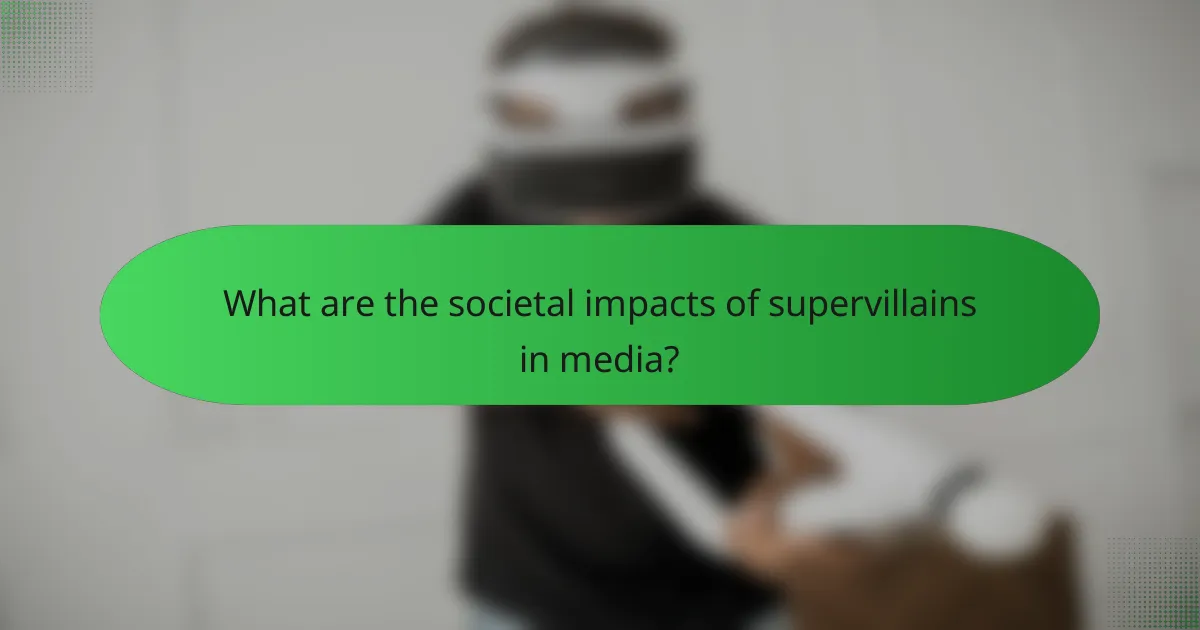
What are the societal impacts of supervillains in media?
Supervillains in media serve as reflections of societal issues, often critiquing norms and highlighting cultural tensions. Their portrayal can influence public perception, shape moral dilemmas, and inspire activism, making them significant figures in contemporary discourse.
Influence on public perception
Supervillains can shape how society views certain groups or ideologies. For example, characters like Lex Luthor or Magneto often embody societal fears about power and control, influencing public attitudes toward authority and rebellion. This portrayal can lead to stigmatization or empathy, depending on the narrative context.
Moreover, the media’s depiction of supervillains can reinforce stereotypes, affecting how individuals perceive real-world issues such as crime, poverty, or mental health. Understanding these influences is crucial for consumers of media to critically assess the messages being conveyed.
Shaping moral dilemmas
Supervillains often present complex moral dilemmas that challenge viewers to consider right versus wrong. Characters like the Joker or Thanos force audiences to confront uncomfortable questions about justice, sacrifice, and the greater good. This can lead to deeper discussions about ethics in society.
These narratives encourage individuals to reflect on their values and the consequences of their choices, making supervillains not just antagonists but catalysts for moral contemplation. Engaging with these dilemmas can help audiences develop a more nuanced understanding of morality in real life.
Inspiring activism and change
Supervillains can inspire activism by highlighting societal injustices and motivating audiences to take action. Characters who fight against corrupt systems, like V from “V for Vendetta,” can galvanize movements for social change, encouraging viewers to challenge the status quo.
Additionally, the narratives surrounding supervillains often resonate with marginalized communities, providing a voice to those who feel oppressed. This connection can lead to real-world advocacy, as fans rally around causes that reflect the struggles depicted in their favorite stories.
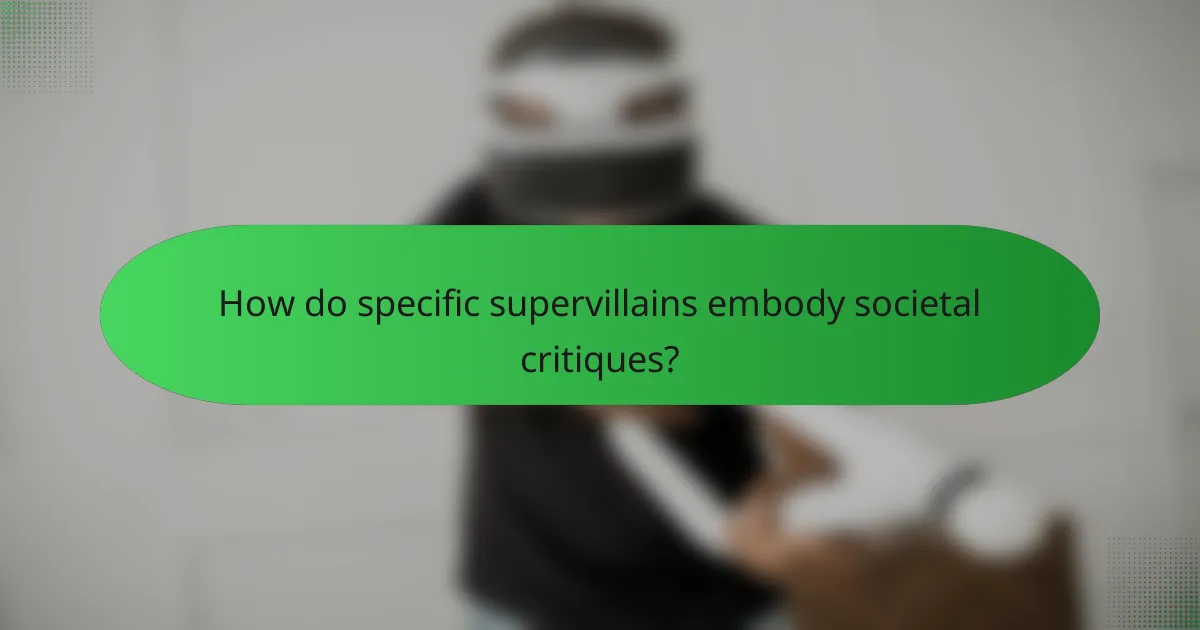
How do specific supervillains embody societal critiques?
Supervillains often serve as reflections of societal issues, critiquing norms and highlighting cultural tensions. Through their actions and motivations, they reveal underlying problems such as discrimination, chaos, and government oppression.
Magneto and discrimination
Magneto, a character from the X-Men series, embodies the struggles against discrimination, particularly in relation to marginalized groups. His backstory as a Holocaust survivor informs his perspective on mutant rights, illustrating the impact of prejudice and systemic oppression.
Magneto’s philosophy suggests that those who are oppressed may resort to extreme measures to protect themselves. This raises questions about the morality of violence in the face of discrimination and the lengths to which individuals will go to achieve equality.
The Joker and chaos theory
The Joker represents chaos theory, challenging the notion of order in society. His actions often highlight the fragility of social structures and how quickly they can unravel under pressure. By creating chaos, he forces society to confront its own vulnerabilities.
This character serves as a critique of the belief that societal norms can maintain stability. The Joker’s unpredictability illustrates how easily people can be driven to madness when faced with existential threats, prompting discussions about mental health and societal responsibility.
V for Vendetta and government oppression
V from V for Vendetta symbolizes resistance against government oppression and totalitarianism. His actions are a direct response to a regime that suppresses freedom and individuality, prompting audiences to reflect on the importance of civil liberties.
The narrative encourages viewers to consider the consequences of complacency in the face of authoritarianism. V’s methods, while extreme, provoke thought about the moral implications of fighting back against oppressive systems and the role of the individual in advocating for change.
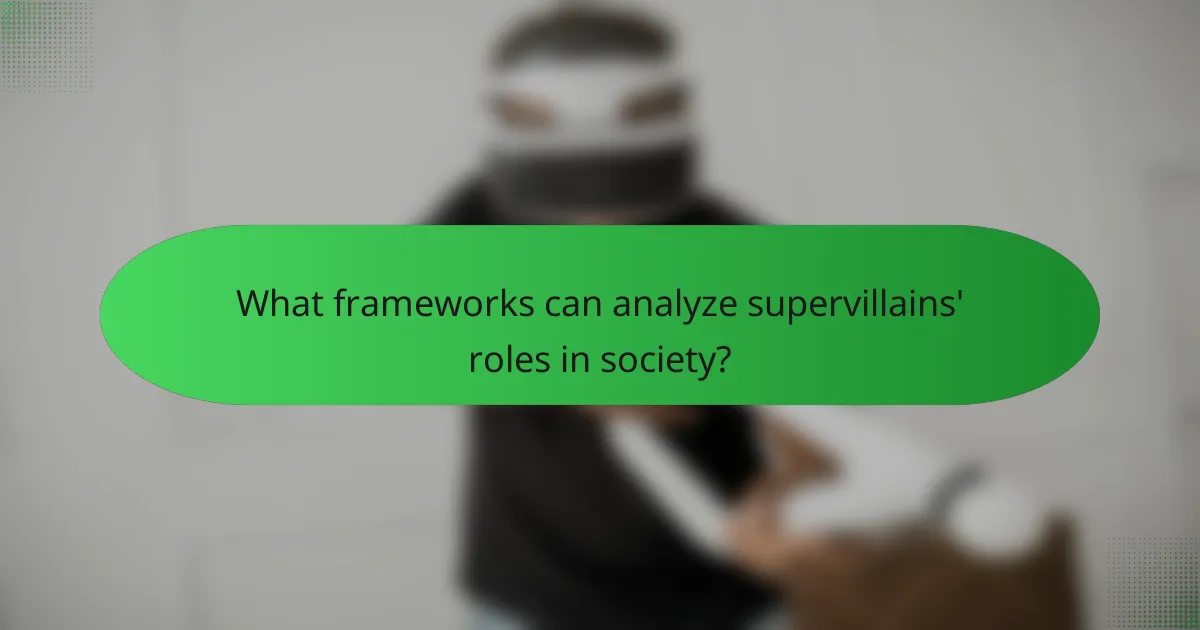
What frameworks can analyze supervillains’ roles in society?
Several analytical frameworks can effectively examine the roles of supervillains in society, highlighting their reflection of societal issues and critique of cultural norms. These frameworks provide insights into how supervillains embody societal fears, values, and conflicts, allowing for a deeper understanding of their cultural impact.
Cultural criticism framework
The cultural criticism framework focuses on how supervillains represent societal anxieties and moral dilemmas. This approach examines the narratives surrounding villains, revealing underlying critiques of power structures, consumerism, and social injustice. By analyzing these characters, one can uncover the cultural commentary embedded in their stories.
For instance, a supervillain like Lex Luthor can be viewed as a critique of unchecked capitalism and the moral ambiguity of wealth. His character raises questions about the ethical responsibilities of the powerful and the consequences of their actions on society. This framework encourages viewers to reflect on the real-world implications of such portrayals.
When applying this framework, consider the historical context of the supervillain’s creation and the societal issues prevalent at that time. Identifying recurring themes can help in understanding how these characters evolve alongside cultural shifts, offering a lens through which to critique contemporary norms.
